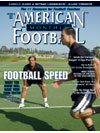AMERICAN FOOTBALL MONTHLY THE #1 RESOURCE FOR FOOTBALL COACHES
Article CategoriesAFM Magazine
|
Football Speed“To boil it down, the difference between football and sprinting is quite simple: it’s displacing momentum into various different angles and dealing with acceleration while changing directions and altering stride patterns.”by: AFM Editorial Staff © More from this issue Dale Baskett specializes in speed. Football speed. Having worked with college powerhouses like Ohio State and Texas A & M and a number of NFL franchises, he’s been making teams faster for 27 years. A former football coach, Baskett made the transition more than a quarter century ago and, in the process, has trained over 100 NFL players including 21 All-Pro’s. During the last nine months, Baskett has authored ‘The Speed Report’ in AFM which has included definitive drills for specific positions (See attached sidebar). AFM research shows that his column is one of the most popular editorials every issue with many subscribers indicating that they would like to learn more from Baskett on the subject of football speed. We took this opportunity to ask him specific questions about football speed, how the industry has changed relat....The full article can only be seen by subscribers. Subscribe today!
|
|
|||||||
| HOME |
MAGAZINE |
SUBSCRIBE | ONLINE COLUMNISTS | COACHING VIDEOS |
Copyright 2025, AmericanFootballMonthly.com
All Rights Reserved





